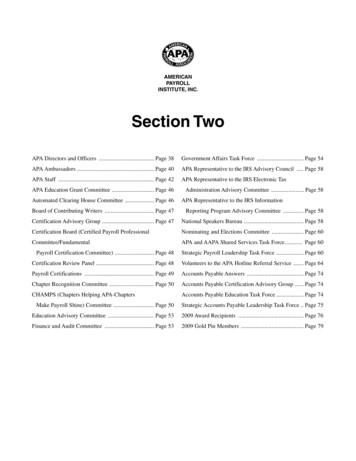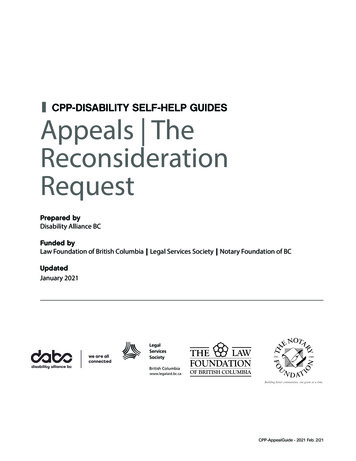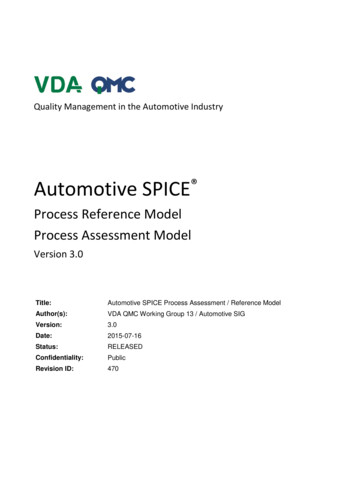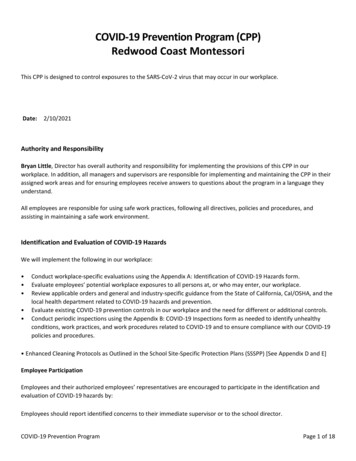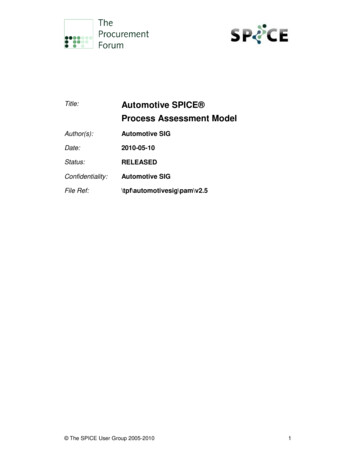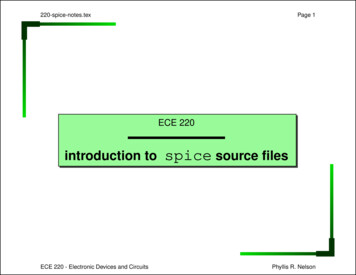
Transcription
220-spice-notes.texPage 1ECE 220introduction toECE 220 - Electronic Devices and Circuitsspice source filesPhyllis R. Nelson
220-spice-notes.texPage 2The Input (*.cir) FileIn pspice, this file must be named filename .cir. The source file for any version ofspice has the following format.TITLEELEMENT DESCRIPTIONS.MODEL STATEMENTSANALYSIS COMMANDSOUTPUT COMMANDS.ENDImportant points: The first line of this file is used as a title on output files. It is not included in the circuitdescription. A common and frustrating error is caused by omitting the title. The file must end with the command .END followed by a newline. Comment entire lines by beginning them with ’*’ or the rest of a line by using a ’;’ Continue a statement on a new line with ’ ’ECE 220 - Electronic Devices and CircuitsPhyllis R. Nelson
220-spice-notes.texPage 3The Circuit DescriptionA circuit description inspice , which is frequently called a netlist, consists of a statementdefining each circuit element.Connections are described by naming nodes. (The usual names are actually numbers.) Onenode name has a defined meaning. Node 0 is ground!The format of an element description is letter name n1 n2 .[mname] [parvals]where . must be present and [.] is optional. letter is a single letter denoting the component type name is a unique alpha-num combination describing the particular instance of thiscomponent ni is the name of a node [mname] is the (optional) model name [parvals] are (sometimes optional) parameter valuesECE 220 - Electronic Devices and CircuitsPhyllis R. Nelson
220-spice-notes.texPage 4Sign ConventionsTwo-terminal elements (including sources!) assume the “load” sign convention V-IThe power P IV associated with an element is positive when the element absorbs power.spice shows sources delivering negative power.ECE 220 - Electronic Devices and CircuitsPhyllis R. Nelson
220-spice-notes.texPage 5Passive ElementsThe letter that begins an element instance denotes the circuit element. The passiveelements areR or r for resistors, L or l for inductors, and C or c for capacitors.This letter is followed by a unique instance name and then (in order) the nodesassociated with and - voltage and the value of the associated parameter (R, L, or C ).Examples: R1 5 0 20k cload nIN GND 250pF L4 122 21 4mHECE 220 - Electronic Devices and CircuitsPhyllis R. Nelson
220-spice-notes.texPage 6Powers of TenThe following abbreviations for powers of ten are recognized byspice teramil (10 3 inch)10 1510 1210 910 610 310 310 610 910 1225.4 10 6spice ignores following letters. Thus 10pF, 10pAmps, and10psec all simply represent the value 10 12 .Once a valid suffix is read,MIL is used to convert distances in thousands of an inch, since spice uses metric lengths.ECE 220 - Electronic Devices and CircuitsPhyllis R. Nelson
220-spice-notes.texPage 7Independent SourcesV name n n- [type] val defines an independent voltage source with its terminal at node n and its - node at node n-.I name n n- [type] val defines an independent current source whose current flows through the source from node n tonode n-.Examples: Vdd 4 0 5defines a 5 V source with the terminal connected at node 4 and the -terminal connected at node 0 (ground) ibias 18 4 DC 15m V2 3 0 25V( spice recognizes the common abbreviations for units, which helps tomake source files more easily understood by humans.)The optional type argument will be described in the analysis commands.ECE 220 - Electronic Devices and CircuitsPhyllis R. Nelson
220-spice-notes.texPage 8Voltage-Controlled Dependent SourcesThe voltage-controlled dependent sources are defined using statements of the form letter name nout nout- nc nc- gain or letter name nout nout- ( nc , nc- ) gain where E is a voltage-controlled voltage source, G is a voltage-controlled current source, theoutput voltage is connected between nodes nout and nout-, and the control voltage ismeasured at node nc with respect to node nc-.Examples: Ex 5 1 4 3 10defines a voltage source that makes node 5 a voltage 10(v4 v3 )above the voltage at node 1 G1 2 1 (5,8) 50mdefines a current source connected between node 2 (the node)and node 1 and supplying a current 50mf(v5ECE 220 - Electronic Devices and Circuits v8 )Phyllis R. Nelson
220-spice-notes.texPage 9Current-Controlled Dependent SourcesThe current-controlled dependent sources are defined by statements of the form letter name nout nout- vcontrol gain where F is a current-controlled current source, H is a current-controlled voltage source, and theoutput current source is connected between nodes nout and nout-, with positive currentflowing through the source from node nout to nout-. The control current flows from thepositive node of the source vcontrol through the source and out the negative node.Examples: Fds 11 9 Vsens 1.25 defines a current source connected from node 11 to node 9that generates a current 1.25 times the current flowing through the source Vsens. H1 30 20 v5 100k defines a voltage source connected from node 30 to node 20 andsupplying a voltage 100 kΩ times the current through the source v5.It is frequently necessary to add a voltage source with value 0 V to the circuit to sensethe control current for these sources!ECE 220 - Electronic Devices and CircuitsPhyllis R. Nelson
220-spice-notes.texPage 10DiodesDiodes are defined using two statements. The netlist definition is of the formD name n n- model-name 4Example:D1 4 2 my-diodecorresponds toD12The model-name must be defined using a .MODEL statement.MODEL model-name D ( [parameter value] .)Continuing the above example,.MODEL my-diode D ( IS 1.4e-18 N 1.2 )where IS is the saturation current and N is the ideality factor (sometimes called the emissioncoefficient). There are approximately 30 parameters which can be specified for diodes. Those notexplicitly specified have default values.ECE 220 - Electronic Devices and CircuitsPhyllis R. Nelson
220-spice-notes.texPage 11Useful Diode Model e saturation currentAmp10 14XTITemperature exponent of IS3NIdeality factor (emission coefficient)1BVReverse breakdown “knee” voltageVolt RSParasitic series resistanceOhm0CJOZero-bias junction capacitanceFarad0ECE 220 - Electronic Devices and CircuitsPhyllis R. Nelson
220-spice-notes.texPage 12Bipolar Junction TransistorsThe BJT also requires both a netlist statement and a .MODEL. A BJT is included in the netlistwith a statement of the formQ name nc nb ne model-name where the collector is connected at node nc, the base at node nb, and the emitter at node ne.Example:6Q3 6 3 0 my-npn corresponds to3Q30The model-name is defined as.MODEL model-name npn pnp ( [parameter value] .)Continuing the example,.MODEL my-npn npn ( BF 175 IS 1e-17 VA 75 BR 2 )where BF is the forward β , IS is the saturation current, VA is the Early voltage, and BR is thereverse β . There are approximately 60 parameters for BJTs.ECE 220 - Electronic Devices and CircuitsPhyllis R. Nelson
220-spice-notes.texPage 13MOSFETsThe BJT again requires both a netlist statement and a .MODEL. A MOSFET is included in thenetlist with a statement of the formM name nd ng ns nb model-name [L value] [W value]where the drain, gate, source, and body are connected at nodes nd, ng, ns, and nbrespectively. The length L and width W are optional.Example:VddMd 4 3 2 10 my-pmos L 1.5u W 4u corresponds to23410MdL 1.5W 4The model-name is defined as.MODEL model-name nmos pmos ( [parameter value] .)Continuing the example,.MODEL my-pmos pmos ( VTO -0.8V KP 5e-4 LAMBDA 0.01)where VTO is the threshold voltage, KP is the transconductance parameter, and LAMBDA isthe channel-length modulation coefficient.ECE 220 - Electronic Devices and CircuitsPhyllis R. Nelson
220-spice-notes.texPage 14SubcircuitsA subcircuit simplifies spice netlists by allowing re-use of a set of circuit elements. Thesyntax isSUBCKT SubName N1 N2 .ENDSThe SubName is the name used to reference the subcircuit, and the nodes are the internalnode numbers used to connect to the subcircuit.A subcircuit can contain any spice netlist statements, including .model statements andother subcircuits.Any elements, nodes, models, subcircuits, or definitions in the subcircuit are completely local tothe subcircuit.ECE 220 - Electronic Devices and CircuitsPhyllis R. Nelson
220-spice-notes.texPage 15* subcircuit example.subckt inverter 1 2 3*input *output *dc supplymp 2 1 3 3 mypmosmn 2 1 0 0 mynmos.model mypmos pmos( . ).model mynmos nmos( . ).endsVdd312 Vdd 30 0 dc 3.6Vvin 10 0 dc 0V301020 vin Xinv1 Xinv240RloadXinv1 10 20 30 inverterXinv2 20 40 30 inverterRload 40 0 100k.dc vin 0 3.6 0.1.endECE 220 - Electronic Devices and CircuitsPhyllis R. Nelson
220-spice-notes.texPage 16.AC Small-Signal Analysis.AC calculates the small-signal response as a function of frequency. The command is.AC type npts f-start f-end where type is one ofLIN (linear sweep) The analysis is repeated at npts linearly-spaced frequencies starting at f-start and ending at f-end .DEC (log sweep by decades) The analysis is repeated at frequencies starting with f-start and ending with f-end . The frequencies are equally-spaced on a log10 scale with npts per decade.OCT (log sweep by octaves) The analysis frequencies start at f-start and end with f-end , with npts points per octave.A source whose frequency is swept has a type designation AC included in its elementdescription.ECE 220 - Electronic Devices and CircuitsPhyllis R. Nelson
220-spice-notes.texPage 17.AC Example1RC circuitr1 1 2 10kc1 2 0 1nvin 1 0 ac 1 dc 0.ac dec 10 .01 10.probe.endECE 220 - Electronic Devices and Circuitsvin10k21nPhyllis R. Nelson
220-spice-notes.texPage 18.DC Sweep.DC calculates the DC voltages and currents in a circuit for a range of values of a chosenvariable or variables. The .DC command has three forms.DC [LIN] var1 s1 e1 d1 [ var2 s2 e2 d2 ]sweeps var1 from s1 to e1 with a linear increment d1. If the second set of values is present,the entire first analysis will be done for each value of var2.DC DEC OCT ] var1 s1 e1 np1 [ var2 .]does a log sweep, adjusting var1 from s1 to e1 in decades (DEC) or octaves (OCT) with np1points per interval. If the second set of values is present, the entire first analysis will be done foreach value of var2.DC var1 LIST val1 val2 [.][ var2 .]performs the analysis for a list of values. Again, the entire first analysis is performed for everyvalue in the second list.A source whose value is used in a .DC sweep has a type designationDC included in itselement description.ECE 220 - Electronic Devices and CircuitsPhyllis R. Nelson
220-spice-notes.texPage 19.DC Example32k1 transistor invertervbias 3 0 5Vvs 1 0 dc 0Vrb 1 2 20krc 3 4 2kq 4 2 0 gennpn.dc vs 0 5 0.05.endECE 220 - Electronic Devices and Circuits1vs 420k2 vbiasPhyllis R. Nelson
220-spice-notes.texPage 20.TF - Transfer Function.TF var-out source-in calculates the small-signal gain from source-in to var-out, as well as the input and outputresistances. If var-out is a current, it must be the current through a voltage source. (You mayhave to add a 0V source to sense this current.)Example:5ktf examplevin 1 0 dc 0.5 Vac 0.1 Vrin 1 2 5kro 2 0 10k.tf v(2) vin.endECE 220 - Electronic Devices and Circuitsvin 10kPhyllis R. Nelson
220-spice-notes.texPage 21.TRAN - Transient Analysis.TRAN calculates the voltages and currents in a circuit as a function of time. The form of thecommand is.TRAN[/OP] print-inc t-end [print-start] [UIC]The operating point for the conditions at the start of the transient analysis is calculated, but willnot be displayed unless the optional .TRAN/OP version of the command is used.print-inc is the time step for the output (not the time step for the calculation!), andt-end is the end of the simulation time period.The optional argument print-start only reports results after that time, and UICindicates that the simulation should use initial conditions. (Initial conditions are set either with a.IC command or by following the element definition of a capacitor with IC voltage andthat for an inductor with IC current .ECE 220 - Electronic Devices and CircuitsPhyllis R. Nelson
220-spice-notes.texPage 22Input Sources for .TRANThe source types available include EXP for exponential waveforms, PULSE, PWL forpiecewise-linear waveforms, and SIN.EXP( v1 v2 [Td1 [Tau1 [Td2 [Tau2]]]])defines an exponential pulse which has an initial value of v1, starts at time Td1, rises with a timeconstant Tau1 until time Td2, then falls with a time constant Tau2.PULSE( v1 v2 [Td [Tr [Tf [pw [tau]]]]])represents a pulse train with low voltage v1 and high voltage v2. The first pulse starts at timeT1, has rise time Tr and fall time Tf, holds v2 for a time pw, and has a period tau.PWL ( t1 v1 [t2 v2 [t3 v3 .]]describes a piecewise-linear waveform with each t)v defining a “corner.”SIN ( v0 va [f [Td [df [phi]]]])defines an exponentially-damped sine waveform with peak amplitude va, frequency f, dampingfactor df, and phase phi in degrees. The waveform has the offset voltage v0, and holds thatvalue for a time Td before the time-dependence begins.ECE 220 - Electronic Devices and CircuitsPhyllis R. Nelson
220-spice-notes.texPage 23.TRAN Exampletran examplevin 1 0 pulse(0V 5V 0 0.1n 0.1n 1u 2u)vcontrol 2 0 dc 5Vmpass 1 2 3 0 mynmos L 5u W 5ucl 3 0 10p.model mynmos nmos(kp 0.01m vto-0.8).tran 0.1u 2.5u.endECE 220 - Electronic Devices and Circuitsvcontrol21 vin3CL-Phyllis R. Nelson
220-spice-notes.texPage 24.OP - Operating PointThe .OP command writes detailed information about the default dc operating point to bewritten in the *.out file. (This information is actually calculated by spice.)The current and power of all voltage sources is given, as well as the small-signal modelparameters for all semiconductor devices.The .TRAN/OP command supplies operating point information for the bias point of atransient analysis.ECE 220 - Electronic Devices and CircuitsPhyllis R. Nelson
220-spice-notes.texPage 25Writing results to a fileThe results of an analysis request can be written to a file using the .PRINT command. Theform of the command is.PRINT type OV1 OV2 Ov3 .The output variables are OV1,OV2, . . . . Node voltages and branch currents can bespecified as magnitude (M), phase (P), real (R), or imaginary (I) by adding the appropriate suffixto V pr I using the following designations:M: MagnitudeDB: Magnitude in dBP: PhaseR: Real partI: Imaginary partExample:.print dc vm(4,0) vdb(4,2) ip(3,2)ECE 220 - Electronic Devices and CircuitsPhyllis R. Nelson
220-spice-notes.tex Page 6 Powers of Ten The following abbreviations for powers of ten are recognized by spice. F P N U M K MEG G T MIL femto pico nano micro milli kilo mega giga tera mil (10 3 inch)10 15 10 12 10 9 10 6 10 3 10 3 10 6 10 9 10 12 25.4 10 6 Once a valid suffix is read, spiceignores following letters.Thus 10pF, 10pAmps, and 10psecall simply represent the value .
